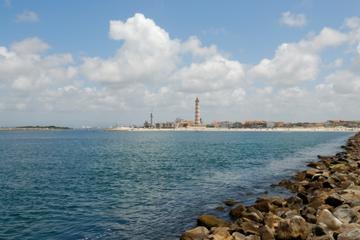
In Roman times, Aveiro was known as Aviarium, which in Latin means “gathering of birds” due to the large number of birds inhabiting the city’s lagoon area. Today, Aveiro is known for being one of the largest metropolitan areas in Portugal (when associated with nearby Ílhavo). It’s also known as the “Venice of Portugal,” as its city is crossed with canals on which boats called barcos moliceiros ferry passengers to and fro.
Aveira’s fortunes have always been tied to the Ria (estuary) and the sea. In contemporary times, the Ria is linked to Aveiro via three canals: the Canal das Pirâmides (marked at its entrance by two stone pyramids), which flows into the Canal de São Roque, and the Canal do Paraíso. Travelers may want to book a tour or plan one of their own that familiarizes them with canals, as they are major avenues of transit and can be overwhelming to first-time visitors.
In terms of attractions, Aveiro’s canals are certainly a must-see. The city’s old-world charm and colorful buildings are underscored by the brightly colored barcos moliceiros pushing across the channels, and the Ria is a fascinating landscape, crisscrossed by intersecting waterways and finger-like peninsulas. Likewise, the city’s beaches are among the best in the country, and surfing is a popular pastime. As the city came into its own in the middle ages, visitors can expect to find centuries-old buildings, including the Aveiro Cathedral and the Igreja de la Misericordia, designed by 18th-century Italian Architect Nicolau Nasoni.
In the days of sail, one of Aveiro's chief exports was blue ceramic tile known as azulejos. Aveiro's contemporary buildings favor an Art Noveau style, and azulejos figure prominently in the designs.
Of course, Aveiro is also known for its not-so-contempoary buildings. Among these, you will want to visit the Convento de Jesus. This 15th century convent was once illicitly sought after by the daughter of King Afonso V, and now it houses the Museu de Aveiro, which houses a large collection of Portuguese Baroque art, as well as sculptures and archeological finds.